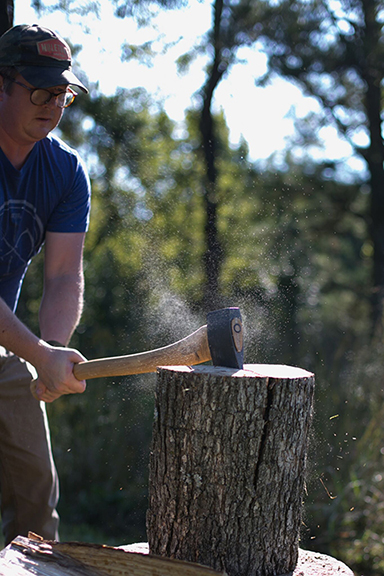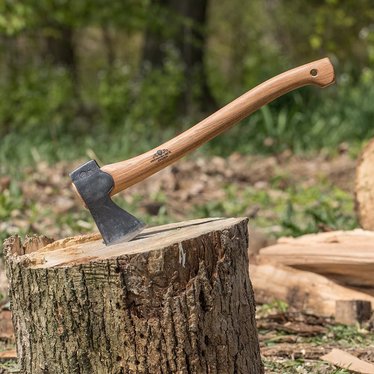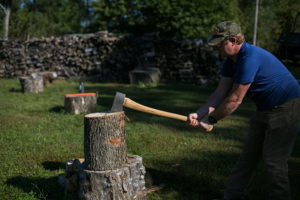When I have procured my firewood and get it back to the woodlot at my farm, the fun really begins. Despite their necessity in working up a truck load of firewood, I really don’t like using chainsaws. They are loud, heavy, smelly and even in the most skilled and experienced of hands, supremely dangerous. Some people enjoy revving them up and feeling powerful with that big ole saw in their hands, but not me. The saw has the juice, not the worker. However, when I have an axe in my hand and pile of wood, I know that I will be the one powering through this stuff and turning it into a nice neat stack of fuel.

Splitting wood with an axe, maul or wedge is a very simple process and once you truly master it, it is very easy work. That doesn’t mean it’s not going to wear you out (it is work after all), but the challenge of splitting the wood lessens the more you apply some brains to all that brawn. The two biggest considerations are the type of wood, which includes the size, condition and quality, and the tool you will be using. Let’s talk wood first.
How to Split Wood
Some people claim that wood is easier to split after it has set, sawn into rounds, for a long period of time. I am not of that ilk. All wood works easier, with a chainsaw or axe, when it is fresh and green. Some species of wood hands down works up better than others. If I had a green oak round that was two feet across and two feet tall in front of me, I would whistle while I worked and in no time have a nice stack of firewood ready to season. If it was elm, well then, I’d probably use it as a place to rest in the woodlot for the next twenty years because it would never split by hand. Assuming the wood is small enough for you to manhandle, then the following principles apply.
First, you need a stump to set your wood to be split on. It should be about 14-18 inches, depending on your height and wider than your widest piece of wood to be worked. A large piece with a few large knots coming out of the side will do since that’s not going to split well anyway.
The wood should be set so that the further edge of the wood to be split is resting on the back edge of the splitting round, leaving material between you and the wood in case there is a mistroke. If the round is unlikely to split with a single, powerful, well-aimed swing down the middle, I start at the back. I will hit the back with a solid stroke to start the split. Then I will follow that one by moving to the middle of the round. The last one is at the front of the round on the side closest to me, along the line the first two strokes have made.

Unless there is a hidden knot, and the wood isn’t elm, it should be split. It may still have some fibers holding it together and that is good. Then the round can be turned and split a few more times before the pieces begin to fall apart. This saves your back from having to lean over and pick up piece after piece, replacing them on the block. Also, just because you are strong and even more powerful with your axe, that doesn’t mean splitting wood is a ‘as hard as you can’ event. After I get a round apart, I rarely swing that hard. For two reasons, one, it just doesn’t require the energy of which I will need a lot to split for long. And two, if I swing super hard and the wood splits, it also flies off the block forcing me to walk over and pick it up, walk it back, set it up and split again.
Choosing Between an Axe and Maul
The next consideration is the tool. My granddad used a double bit axe for everything, including splitting. I mix it up between axes and mauls depending on the size and species of the wood. Serious wood splitting though is maul work. I like something under eight pounds and so I can swing it all day without too much fatigue. Those eight and twelve pounders do a great job, but are much harder on your hands and back. I also like a razor sharp edge. It’s not required for the splitting aspect, but some woods can be very fibrous and a few short strokes with a sharp maul clean these up nicely and don’t require power swings that wear you down.































[…] Note: Want to learn more about wood heating? Make sure to check out Patrick’s posts about splitting wood by hand and how to choose the right […]
[…] Chopping your own wood by hand is rewarding, but a good axe is essential. These dependable axes get the job done right! […]